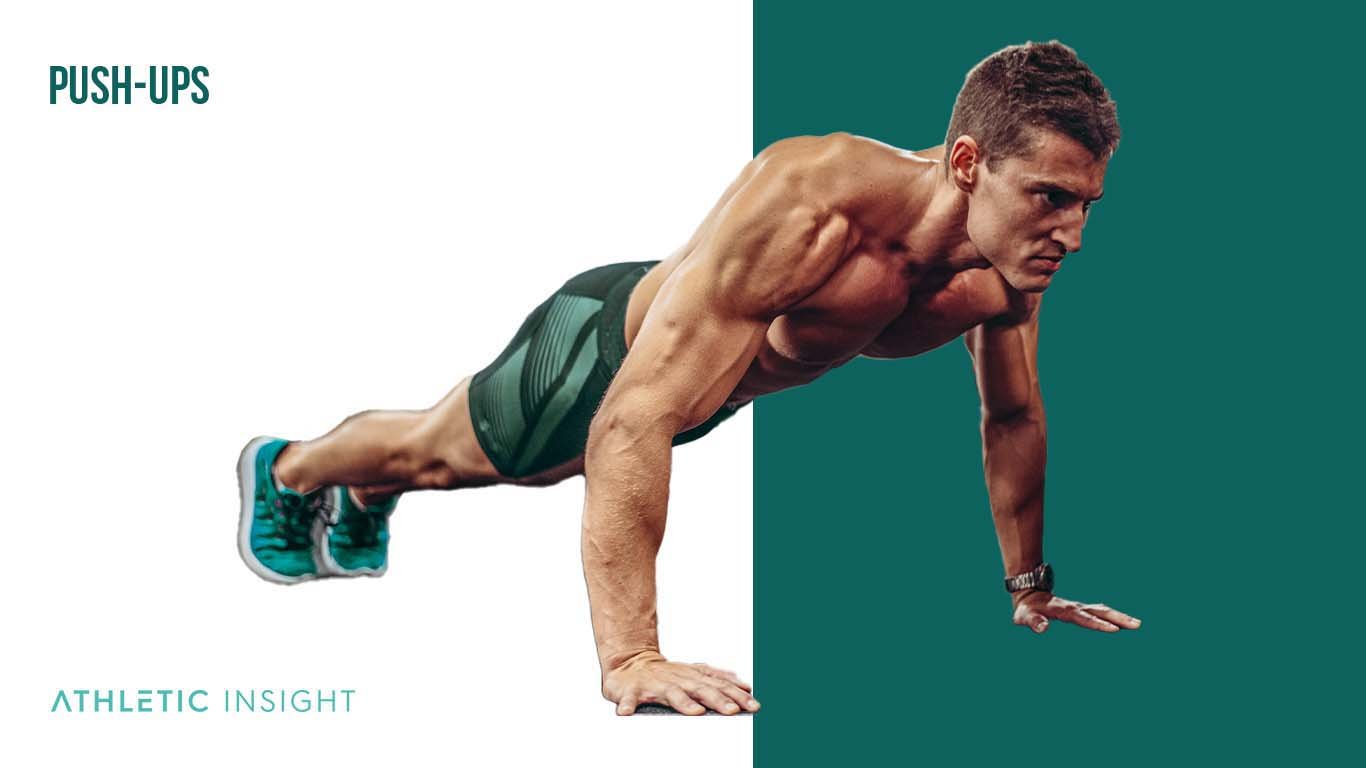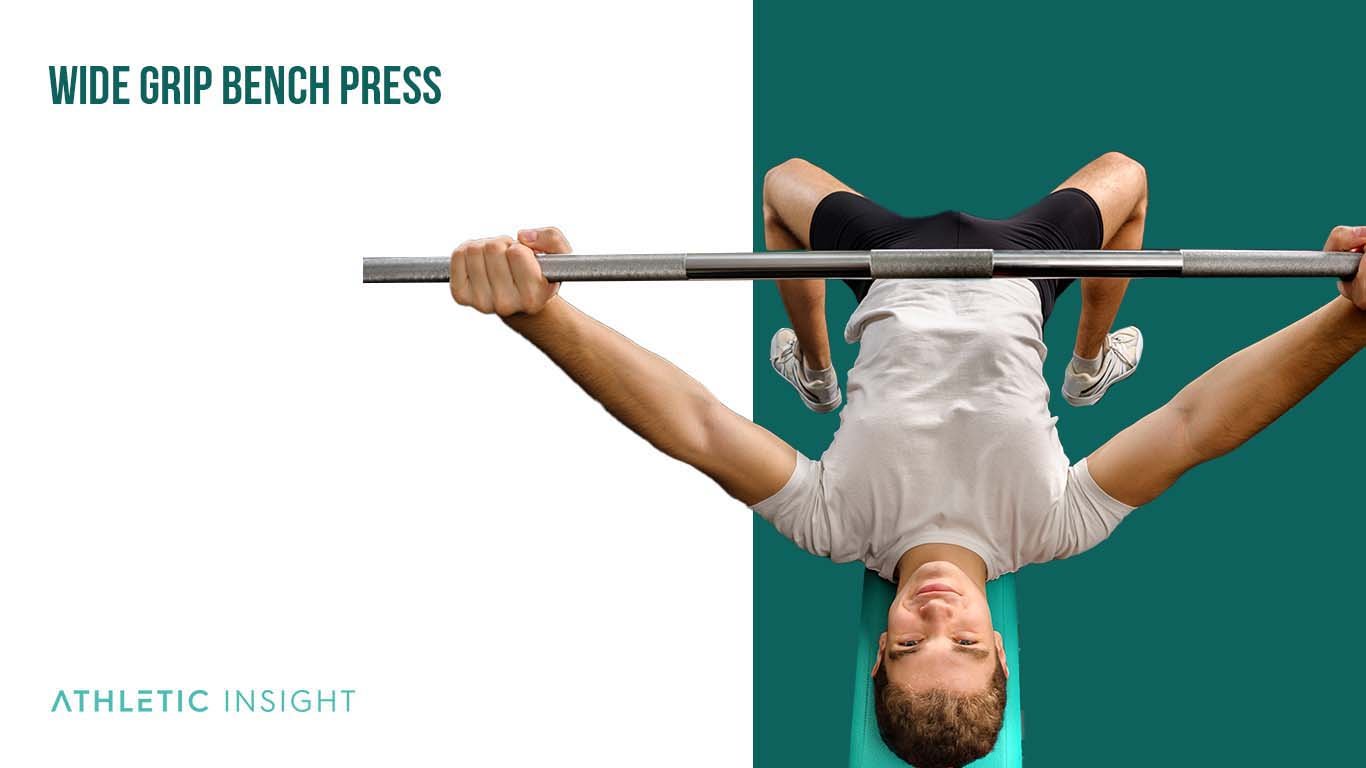Chest fly alternatives are additional exercises that you can do that target the same muscles as the traditional chest fly. Some of these alternatives are used to target a particular muscle or muscle group. Chest fly alternatives can benefit all types of athletes at any skill level.
There are nine common chest fly alternatives, all of which serve a unique purpose. Some chest fly alternatives require a higher number of reps to see results, whereas others demand a higher weight and fewer reps.
Chest fly alternatives are hugely popular in the fitness community. Beginner athletes frequently use exercise alternatives when starting to build enough muscle to do the original exercise. However, experienced athletes commonly customize their workouts and make use of exercise alternatives (and variations) to maximize the experience and productivity of a workout.
1. Push-Ups
A push-up is a suitable chest fly alternative that works many muscles simultaneously. Push-ups primarily target the pectorals, deltoids, triceps, abdominals, and serratus anterior (the muscle directly beneath your armpit). Almost every athlete incorporates push-ups into their routine to a certain extent, no matter their focus.

The push-up is, in part, popular because it relies solely on body weight and can be done anywhere. Athletes who prioritize speed and endurance over strength use push-ups as a simplistic way to complement their pursuits with strength training.
There are many variations of push-ups; standard, modified, wide, narrow, decline, plyometric. Each one changes the effects of a push-up slightly. Standard and modified push-ups work muscles in the chest, whereas wide and decline push-ups incorporate shoulder work in addition to the chest. Narrow push-ups work the chest and triceps, and plyometrics are the most challenging push-ups targeting muscles in the chest.
A common mistake while doing a push-up is not lowering your body enough. To ensure a productive workout, try a modified push-up if you’re not yet ready for the standard. Remember to keep your back level rather than arched or concave to prevent injury.
In terms of difficulty, a single standard push-up average difficulty wherein most males that are a helathy weight can perform at least a few repitions. For women, and overweight males, push-ups tend to be a bit more difficult.
2. Floor Fly
Floor flys are great for your pectoral muscles. A floor fly requires two dumbbells and a flat surface to lie on. Floor flys are usually completed in several sets of 8 to 12 reps with brief rest periods between the sets. Floor flys are challenging, and experienced athletes recommend starting with just 10% of your bench press weight.
Start by holding the dumbbells above your shoulders, but don’t lock your elbows, or you run the risk of injury. Lower the dumbbells out to the side to align your elbows with your chest when they touch the floor. Hold the position for a moment before lifting the dumbbells back up towards one another, so they end up where they were originally.
Mistakes are easy to make while doing a floor fly. To ensure safety and productivity, keep your neck relaxed and don’t let the dumbbells touch each other, so your pecs don’t have any resting period during a rep.
In terms of difficulty, a single floor fly using the recommended weight is of average difficulty. To quantify it on a scale of 1 to 10, the floor fly would be a 6 in terms of muscles used and the difficulty of form.
3. Incline Bench Press
Incline bench presses are chest fly alternatives where the bench is set at a 15 to 30-degree incline. Like flat bench presses, they utilize the pectoralis major, anterior deltoid, and triceps brachii muscles. The incline bench press focuses attention on the upper pectorals and the shoulders.
To ensure proper form, grip the bar so your elbows are at a 90-degree angle. When you lower the bar, hold it for a moment as close to your chest as possible without resting it there. Complete five sets of 8-12 reps using the highest weight possible.
The incline bench press puts less pressure on your rotator cuff than many pectoral exercises, making it a safer chest fly alternative. Take care to let your deltoids rest as well as your pectorals after your workout, or you risk injury from overworking the muscles.
In terms of difficulty, a single incline bench press with the proper weight is a 4 out of 10. Most beginners can perform this movement but may require less weight. Although relatively easy to perform, there is a lot of room for error.
4. Plate Squeeze
Plate squeezes, also called plate pinch presses, are chest fly alternatives targeting the fibers of the inner chest. These exercises are suitable for isolating the chest in a workout. Plate squeezes don’t require much weight to be effective.
Hold two weight plates vertically by squeezing them together between your palms. Again, very little weight is necessary. Two 10-pound plates should be more than enough for beginners. Extend your arms forward and away from your body at a slight upward angle and reverse the motion to complete a rep.
Avoid using your laterals or anterior deltoids for this exercise to get good results. Plate squeezes are good exercises for avoiding stress to the shoulders due to an injury.
In terms of difficulty, a single plate squeeze is a 5 out of 10. While it may seem like a simple movement, the plate squeeze is a compound exercise that requires perfect form and attention throughout the entire rep. Failure may result in a serious injury.
5. Wide Grip Bench Press
The wide grip bench press chest fly alternative entails gripping the bar at up to twice the width between your shoulders. This exercise emphasizes work on the pectorals, the shoulders, and the triceps and makes pressing the barbell easier to do than it is during an ordinary bench press.

Official powerlifting rules for the bench press state that a grip can’t be wider than 81 centimeters. A wide grip bench press may be more challenging than a standard bench press if your pectorals are not particularly strong. Follow proper weightlifting safety techniques and use a spotter to avoid injury.
In terms of difficulty, a single wide grip bench press is a 7 out of 10. Although the form is similar to a standard bench press, the weight is harder to move despite the shorter range of motion in the repition. Too much weight may result in a shoulder injury.
6. Front Raises for Chest
Front raises for the chest, commonly known as dumbbell front raises, are chest fly alternatives that mainly strengthen the deltoids, also targeting the upper pectorals and lateral muscles.

Front raises are isolating shoulder flexion exercises, meaning they entail the movement of dumbbells from a resting position at your side to be held straight above your head. The muscles used in these types of exercises are the anterior deltoid, pectoralis major, and coracobrachialis.
The variations of dumbbells front raises target particular muscles and serve different purposes. The seated dumbbell raise, lateral dumbbell raise, front incline dumbbell raise, and alternating dumbbell front raise all employ the same basic shoulder flexion motion.
Avoid flexing your wrists and evenly distributing your weight between your legs to have a safe workout and get balanced results. Try to avoid using momentum to lift the weight to maximize productivity.
In terms of difficulty, a single front raise for the chest is a 5 out of 10. While the front raise is simple to perform, it has an overall average difficulty level because of limited weight that one can lift during this exercise. It is best to start off with light weights and slowly scale up once you are ready.
7. Archer Push-Ups
Archer push-ups, or side-to-side push-ups, build strength in the back and arms. Increasing your skill in archer push-ups will increase your capability of doing single-arm push-ups. One arm at a time supports your body, while the other arm is used for support and balance. No equipment is necessary for these.
Do a few sets of 8-12 reps per side. Squeeze your quads and glutes to activate the proper muscle groups. Allow your body to rest before a workout targeting a particular muscle group to avoid injury.
A few other push-up variations serve a similar purpose to archer push-ups; diamond push-ups, pike push-ups, and typewriter push-ups.
In terms of difficulty, a single archer push-up is an 8 out of 10. The archer push-up is not only harder than a conventional push-up, but it is difficult for most men to perform that find the traditional push-up easy to perform.
8. Sliding Push-Up
Sliding push-ups are chest fly alternatives targeting the arms, shoulders, and chest, plus the abdominals. You will need an exercise slider, which is a cheap and portable way to intensify a workout.
The only difference between standard and sliding push-ups is that for sliding push-ups, you extend an arm out in front of you using the slider while holding the typical lowered position.
Sliding push-ups are another way to work up to single-arm push-ups. Like all push-ups, sliding push-ups are a full-body workout to a certain extent, exercising your hip flexors, hamstrings, and glutes in addition to your chest and abdominals.
Just a few reps per set, around 5 to 10, are enough for the sliding push-ups to do their job. Tuck in your chin and continually engage your core while doing your reps.
In terms of difficulty, a single sliding push-up is an 8 out of 10. Just like the archer push-up, a sliding push-up poses some difficulty for those that can perform regular push-ups without struggle.
9. Cable Chest Press Crossover
The cable chest press crossover utilizes a cable machine. Cable machines in most gyms have a wide range of capabilities, but the cable chest press crossover, in particular, is a great chest fly alternative.
Depending on the position of the machine’s handles, the cable chest press crossover activates different chest muscles. Cables in a low position target the upper chest, at shoulder height target the middle chest, and above the head target the lower chest.
Don’t allow your elbows to bend while completing reps of the cable chest press crossover. Each rep should be thorough and not rushed to ensure the full effects of the exercise.
In terms of difficulty, an average repetition of the cable chest press crossover is a 7 out of 10. With light weight, this exercise is easy to perform, but if you are trying to work your muscles out in the same fashion as you would with a regular bench press, the cable will prove to be a difficult adversary to overcome as it requires balance throughout the lift.
What to Know About Chest Fly Alternatives
Chest fly alternatives are constructive for building muscle in the chest and surrounding muscle groups. Choosing alternatives allows you to target specific muscles and alleviate stress on others to avoid injury.
The default chest fly is a basic, effective way to gain muscle in your chest, but its alternatives are equally beneficial and can be even more so if you have unique needs or a more specific goal in mind for your workout.
Which chest fly alternative is more beginner-friendly?
Push-ups and the wide grip bench press are the most beginner-friendly chest fly alternatives listed above.
Which chest fly alternative is better for the chest?
Floor flys, plate squeezes, and sliding push-ups are the best chest fly alternatives and they are are simple chest exercises anyone can do.
Which chest fly replacement exercise is better for triceps?
Narrow push-ups and the incline bench press are the best chest fly replacement exercises, particularly for the triceps of the exercises listed above.
Which chest fly substitute is better for strength?
Floor flys, archer push-ups, sliding push-ups, and the cable chest press crossover are the best chest fly substitutes, focusing on strength-building rather than the endurance of the exercises listed above.
When should an athlete use chest fly alternatives for exercise?
Chest fly alternatives can benefit all athletes. The many variations serve different purposes, so adding the exercise to a workout routine can benefit anyone, regardless of the goal, skill level, or presence of injury.
What are the advantages of diversifying chest fly?
Diversifying chest fly exercises is a great way to balance the emphasis on specific muscles and muscle groups. Doing a variety of exercises rather than repeatedly doing the same ones reduces the risk of injury.
Can chest fly alternatives replace the chest fly?
Yes, a chest fly alternative can replace the chest fly. Chest fly alternatives don’t do exactly what a default chest fly does, but they all provide at least a portion of the results and can replace the default chest fly in certain combinations.
What is the chest fly variations?
Chest flys and their alternatives can be completed using cables, dumbbells, or machines. Some of the chest fly variations target the entire chest, while others specifically target the upper, middle, or lower portion of the chest.



